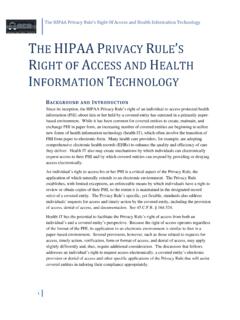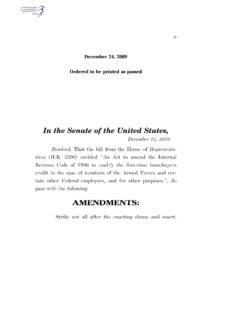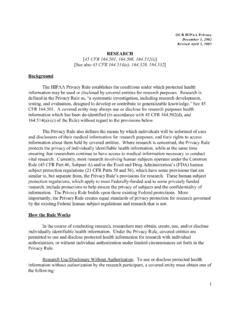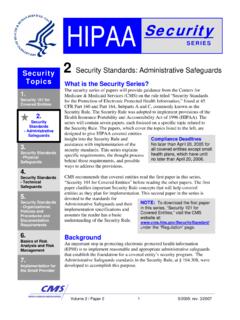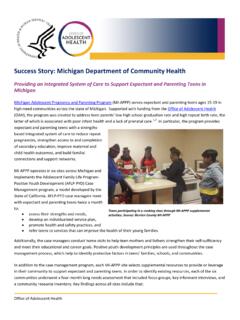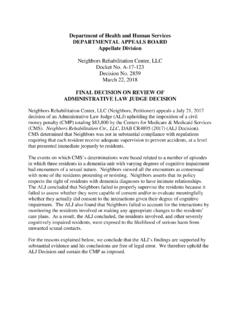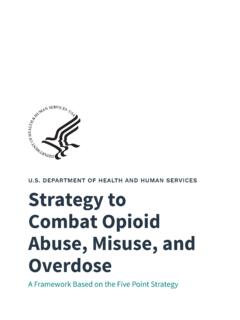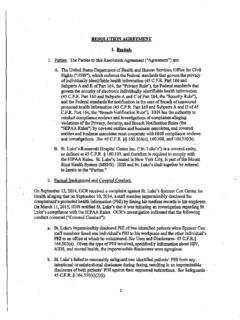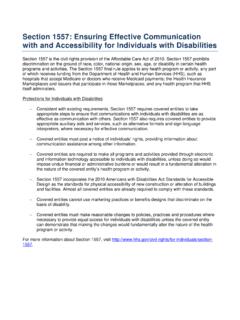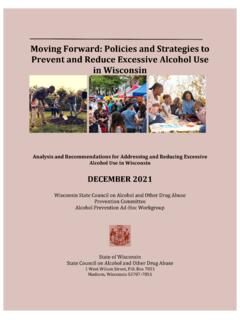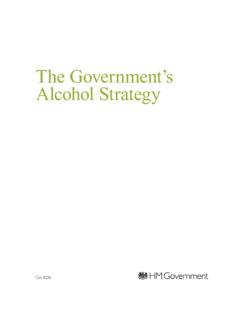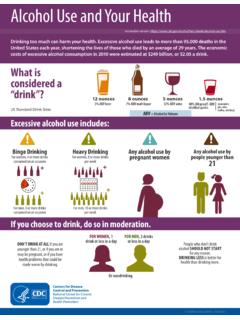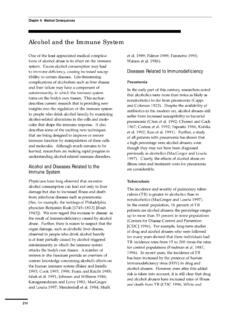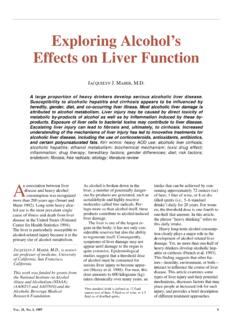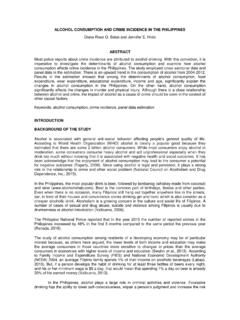Transcription of National Prevention Strategy - HHS.gov
1 National Prevention StrategyJune 2011 AMERICA S PLAN FOR BETTER HEALTH AND WELLNESSOFFICE of the SURGEON GENERAL 5600 Fishers LaneRoom 18-66 Rockville, MD 20857email: citation: National Prevention Council, National Prevention Strategy , Washington, DC: Department of Health and Human Services, Office of the Surgeon General, more information about the National Prevention Strategy , go to: Prevention , Health Promotion and Public Health CouncilNational Prevention StrategyAmerica s Plan for Better Health and WellnessJune 16, 201123 National Prevention StrategyMessage from the Chair of the National Prevention , Health Promotion, and Public Health CouncilAs Surgeon General and Chair of the National Prevention , Health Promotion, and Public Health Council ( National Prevention Council), I am honored to present the nation s first ever National Prevention and Health Promotion Strategy ( National Prevention Strategy ).
2 This Strategy is a critical component of the Affordable Care Act, and it provides an opportunity for us to become a more healthy and fit National Prevention Council comprises 17 heads of departments, agencies, and offices across the Federal government who are committed to promoting Prevention and wellness. The Council provides the leadership necessary to engage not only the federal government but a diverse array of stakeholders, from state and local policy makers, to business leaders, to individuals, their families and communities, to champion the policies and programs needed to ensure the health of Americans prospers. With guidance from the public and the Advisory Group on Prevention , Health Promotion, and Integrative and Public Health, the National Prevention Council developed this National Prevention Strategy will move us from a system of sick care to one based on wellness and Prevention . It builds upon the state-of-the-art clinical services we have in this country and the remarkable progress that has been made toward understanding how to improve the health of individuals, families, and communities through Prevention .
3 The National Prevention Strategy encourages partnerships among Federal, state, tribal, local, and territorial governments; business, industry, and other private sector partners; philanthropic organizations; community and faith-based organizations; and everyday Americans to improve health through Prevention . For the first time in the history of our nation, we have developed a cross-sector, integrated National Strategy that identifies priorities for improving the health of Americans. Through these partnerships, the National Prevention Strategy will improve America s health by helping to create healthy and safe communities, expand clinical and community-based preventive services, empower people to make healthy choices, and eliminate health disparities. We know that preventing disease before it starts is critical to helping people live longer, healthier lives and keeping health care costs down. Poor diet, physical inactivity, tobacco use, and alcohol misuse are just some of the challenges we face.
4 We also know that many of the strongest predictors of health and well-being fall outside of the health care setting. Our housing, transportation, education, workplaces, and environment are major elements that impact the physical and mental health of Americans. This is why the National Prevention Strategy helps us understand how to weave Prevention into the fabric of our everyday lives. The National Prevention Council members and I are fully committed to implementing the National Prevention Strategy . We look forward to continuing our dialogue with all stakeholders as we strive to ensure that programs and policies effectively help us accomplish our vision of a healthy and fit nation. Regina M. Benjamin, MD, Surgeon GeneralChair of the National Prevention , Health Promotion, and Public Health Council4 National Prevention , Health Promotion, and Public Health CouncilMembers Surgeon General Regina M. Benjamin, Council Chair Secretary Kathleen Sebelius, Department of Health and Human Services Secretary Tom Vilsack, Department of Agriculture Secretary Arne Duncan, Department of Education Chairman Jon Leibowitz, Federal Trade Commission Secretary Ray LaHood, Department of Transportation Secretary Hilda L.
5 Solis, Department of Labor Secretary Janet A. Napolitano, Department of Homeland Security Administrator Lisa P. Jackson, Environmental Protection Agency Director R. Gil Kerlikowske, Office of National Drug Control Policy Director Melody Barnes, Domestic Policy Council Assistant Secretary-Indian Affairs Larry Echo Hawk, Department of the Interior Acting Chief Executive Officer Robert Velasco II, Corporation for National and Community Service Secretary Robert M. Gates, Department of Defense Secretary Shaun Donovan, Department of Housing and Urban Development Attorney General Eric H. Holder, Jr., Department of Justice Secretary Eric K. Shinseki, Department of Veterans Affairs Director Jacob J. Lew, Office of Management and Budget5 Table of ContentsMessage from the Chair of the National Prevention , Health Promotion, and Public Health Council ..3 National Prevention , Health Promotion, and Public Health Council ..4 Table of Contents.
6 5 Introduction ..6 National Leadership ..8 Partners in Prevention ..9 Strategic Directions and Priorities ..11 Strategic DirectionsHealthy and Safe Community and Community Preventive Services ..18 Empowered People ..22 Elimination of Health Disparities ..25 PrioritiesTobacco Free Living ..28 Preventing Drug Abuse and excessive Alcohol Use ..31 Healthy Eating ..34 Active Living ..38 Injury and Violence Free Living ..41 Reproductive and Sexual Health ..44 Mental and Emotional Well-being ..48 AppendicesAppendix 1: Economic Benefits of Preventing Disease ..51 Appendix 2: National Prevention Strategy Indicators ..52 Appendix 3: Stakeholder Outreach and Input ..61 Appendix 4: Advisory Group on Prevention , Health Promotion, and Integrative and Public Health ..62 Appendix 5: Justification for Evidence-Based Recommendations ..63 Appendix 6: References for the Key Documents ..82 Appendix 7: End Notes ..876 IntroductionThe strength and ingenuity of America s people and communities have driven America s success.
7 A healthy and fit nation is vital to that strength and is the bedrock of the productivity, innovation, and entrepreneurship essential for our future. Healthy people can enjoy their lives, go to work, contribute to their communities, learn, and support their families and friends. A healthy nation is able to educate its people, create and sustain a thriving economy, defend itself, and remain prepared for emergencies. The Affordable Care Act, landmark health legislation passed in 2010, created the National Prevention Council and called for the development of the National Prevention Strategy to realize the benefits of Prevention for all Americans health. The National Prevention Strategy is critical to the Prevention focus of the Affordable Care Act and builds on the law s efforts to lower health care costs, improve the quality of care, and provide coverage options for the disease and injuries is key to improving America s health.
8 When we invest in Prevention , the benefits are broadly shared. Children grow up in communities, homes, and families that nurture their healthy development, and people are productive and healthy, both inside and outside the workplace. Businesses benefit because a healthier workforce reduces long-term health care costs and increases stability and productivity. Furthermore, communities that offer a healthy, productive, stable workforce can be more attractive places for families to live and for businesses to locate. Although America provides some of the world s best health care and spent over $ trillion for health in 2009, the still ranks below many countries in life expectancy, infant mortality, and many other indicators of healthy Most of our nation s pressing health problems can be prevented. Eating healthfully and engaging in regular physical activity, avoiding tobacco, excessive alcohol use, and other drug abuse, using seat belts, and receiving preventive services and vaccinations are just a few of the ways people can stay healthy.
9 Health is more than merely the absence of disease; it is physical, mental, and social Investments in Prevention complement and support treatment and care. Prevention policies and programs can be cost-effective, reduce health care costs, and improve productivity (Appendix 1). The National Prevention Strategy s core value is that Americans can live longer and healthier through Prevention . Many of the strongest predictors of health and well-being fall outside of the health care setting. Social, economic, and environmental factors all influence People with a quality education, stable employment, safe homes and neighborhoods, and access to high quality preventive services tend to be healthier throughout their lives and live longer. When organizations, whether they are governmental, private, or nonprofit, succeed in meeting these basic needs, people are more likely to exercise, eat healthy foods, and seek preventive health services.
10 Meeting basic needs and providing information about personal health and health care can empower people to make healthy choices, laying a foundation for lifelong wellness. Preventing disease requires more than providing people with information to make healthy choices. While knowledge is critical, communities must reinforce and support health, for example, by making healthy choices easy and affordable. We will succeed in creating healthy community environments when the air and water are clean and safe; when housing is safe and affordable; when transportation and community infrastructure provide people with the opportunity to be active and safe; when schools serve children healthy food and provide quality physical education; and when businesses* provide healthy and safe working conditions and access to comprehensive wellness programs. When all sectors ( , housing, transportation, labor, education, defense) promote Prevention -oriented environments and policies, they all contribute to health.
